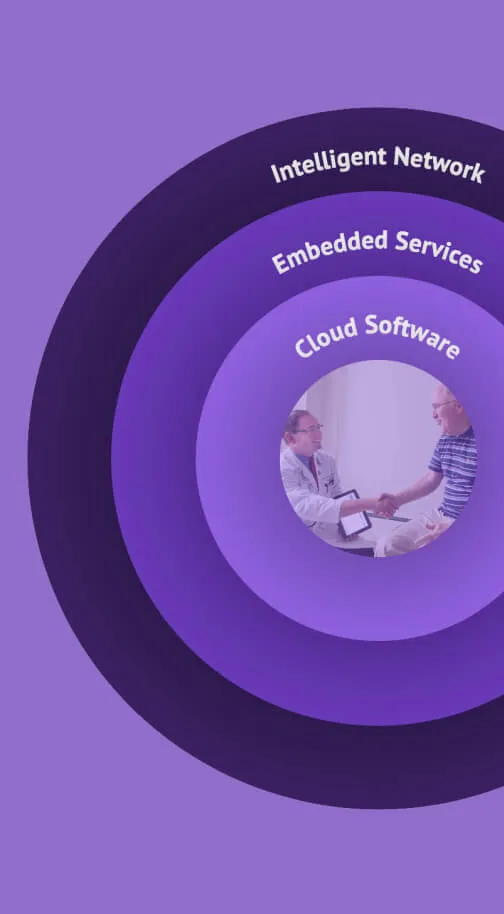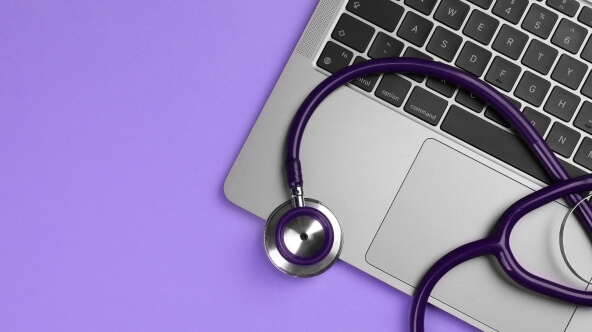Is it time for an EMR or EHR transition?
Healthcare technology has progressed dramatically since the American Recovery and Reinvestment Act (ARRA) mandated the use of electronic medical records (EMR).1 If your practice is still using an ARRA-era EMR system, or even one of the many common EHR systems that have been developed since 2009, you may find that it is no longer as secure and useful as it once seemed. An outdated EMR system can quickly lead to unscalable administrative work, poor patient care coordination, and even compliance issues.
Is it time for an EMR replacement? Here are key signs that your current EMR system might not be up to the task:
1. Inefficient workflow and user experience issues
Is your EMR intuitive to use? An outdated or poorly designed EMR can create significant workflow inefficiencies, affecting the speed and quality with which you deliver care. If your team is spending a disproportionate amount of time on administrative tasks—such as data entry, navigating confusing interfaces, or searching for patient information—it could be a sign that your EMR system is not user-friendly.
Additionally, if your clinicians and staff are consistently frustrated with the system's performance or having trouble adopting new features, it may be time for an upgrade. Medical practices that don’t prioritize EHR usability and continue to work with cumbersome, outdated EMR systems are more likely to experience increasing errors, decreasing staff satisfaction, and burnout.
2. Lack of customization for specialty workflows
Is your EMR flexible enough to support your specialty? Not all EMR systems are designed to meet the specific needs of specialized medical practices. If your current EMR doesn’t allow for customization or configuration to fit the unique workflows of your specialty (whether it’s orthopedics, women’s health, urgent care, etc.), it can cause delays and frustrations, especially when you’re face-to-face with a patient. A lack of flexibility in how your EMR handles your practice’s specific processes (like appointment scheduling, charting, or treatment protocols) can hinder clinical productivity.
Moreover, if your system doesn’t support API integrations that allow you to connect with other specialized software or applications that your practice uses, it may require extra manual work or additional tools to accomplish tasks. If you're unable to tailor your EHR experience with integrated add-ons, you may find yourself repeating data entry across multiple systems—or building and maintaining these integrations yourself.
3. Standalone functionality requiring additional software to get everything you need
Can you access your clinical inbox, patient charts, and claims processing from a single place? Many practices find themselves cobbling together multiple software solutions to meet all their needs, such as a localized EMR for patient medical records, separate software for medical billing or practice management, and other tools for patient engagement. This can lead to inefficiencies and inaccuracies, as these systems often don’t share information easily. Whether it’s dealing with data duplication, navigating multiple interfaces, or manually transferring information from one system to another, the lack of integration between systems puts you at risk.
If your EMR or even your cloud-based EHR doesn’t work well with other systems or doesn’t provide an all-in-one solution, you could be spending more time on administrative tasks and data reconciliation than on patient care. If that’s the case, it’s likely time for an EHR migration.
4. Failure to support value-based care performance
Is your EMR developed to support your success in value-based care programs? Many legacy EMR systems were built when fee-for-service care models dominated the healthcare landscape.2 As healthcare continues to evolve toward value-based care—where reimbursement is tied to patient outcomes and quality measures—an EMR that does not efficiently support your success in Alternative Payment Models (APM) can hold you back from leveraging these increasingly important programs. This support should come in the form of features like knowledgeable and experienced support resources, capabilities to track and analyze population health, and data- and evidence-based clinical decision support.
If your EMR lacks the tools monitor and optimize your VBC performance (both today and into the future), you may be missing out on revenue opportunities and face penalties or reduced reimbursement rates for non-compliance.
5. Limited mobile or remote access
Can you access your EMR from multiple care sites and on-the-go? Busy physicians and surgeons often move between the operating room or ambulatory surgery center (ASC), hospital and clinical rounds, and various care sites, or even simply between patient rooms a clinic. Accessing patient records from various locations, including home, traveling, or otherwise on the go can make you more efficient. If your current EMR system lacks mobile access or remote capabilities, you may be putting yourself and your practice at a disadvantage, wasting time waiting at the office for lab results to come in, or delaying care until you’re back on-site and can log-in to your system.
Physicians and clinicians who are digitally connected through mobile apps or cloud-based solutions can provide better care by accessing patient information in real time, improving coordination, and reducing response times. If your EMR or EHR doesn’t provide these capabilities, it may limit the ability of your team to offer flexible, responsive care.
6. Vulnerability to cyberattacks
Is your EMR secure against cyber threats? Older EMR systems may lack the latest cybersecurity protocols or encryption capabilities, putting patient data at risk.
Modern, cloud-based SaaS EHRs include robust EHR security features to protect against unauthorized access, ransomware, and other threats. Importantly, the vendor that delivers the SaaS platform is responsible for monitoring security, not you and your busy staff. If your current EMR does not offer the latest in data protection and security measures, it could expose your practice to legal, financial, and reputational risks.
7. Inability to share information across systems
Is your EMR well connected? One of the biggest limitations of many EMR systems is their inability to easily share patient data with other healthcare providers and integrate with other healthcare systems. If your EMR does not support data exchange or interoperability—or if it leaves the technical work of implementing and maintaining those connections to you—it’s a sign that it may be time to transition your technology.
If your on-premises EMR or hosted EHR system is unable to connect with other systems and technologies, it can create silos of information that hinder your ability to provide comprehensive, coordinated care. Practices that rely on disconnected systems may experience errors in data entry, duplicate care, and delays in treatment.
8. High cost of maintenance and updates
Is your EMR software updated automatically without causing disruption? Some legacy EMR systems can become costly to maintain, especially if the software vendor no longer provides adequate support, updates, or training. If you find yourself paying high fees for system maintenance, software patches, or additional modules that should be standard—or if you’re simply putting these updates off because they’re too costly— it might indicate that your system is outdated.
Switching EHR systems can result in long-term cost savings by reducing inefficiencies, eliminating the need for additional support services, and ensuring that your practice is equipped with the latest features and security updates. Choosing a cloud-based SaaS EHR means these updates should be done automatically, and without causing significant downtime to your system or delays in your standard operations.
9. Futureproofing and AI capabilities
Is your EMR built to incorporate emerging technologies? Artificial intelligence (AI) and machine learning are starting to play a larger role in enhancing clinical decision-making and reducing administrative burdens in healthcare. If your current EMR lacks AI capabilities or the ability to evolve with emerging technologies, you may be left behind as other practices leverage these innovations to enhance care.
A future-proof EHR system will have the capability to incorporate new features, provide predictive analytics, and continuously adapt to the changing healthcare landscape. If your EMR can't adapt to this ever-changing industry, you risk investing in a system that will soon become obsolete, putting you in line for another EHR transition in the near future.
Upgrading your EMR software
If your practice is experiencing any of these issues with your EMR, it’s time to evaluate whether it still meets your needs. A modern, interoperable EHR system can improve care coordination, enhance patient engagement, streamline workflows, and support participation in quality and value-based care programs. Migrating to a new system and navigating an EHR implementation can feel daunting, but it can pay off in improved operational efficiency, better patient outcomes, and the ability to stay compliant with evolving healthcare regulations.
An outdated EMR system can quickly lead to inefficiencies, poor patient care coordination, and even compliance issues.
Discover the athenaOne difference
If you’re wondering how to select an EHR, you’ve arrived at the right place. athenaOne is a leading healthcare IT platform with award-winning EHR capabilities. Our EHR is part of our all-in-one solution, with practice management, medical billing, and patient engagement capabilities all integrated together. This technology is backed with expert services—including onboarding specialists—to ensure you and your team are successful with athenaOne, from day-1 and beyond.
When you select athenaOne, you are teaming up with more than a technology provider. From our unique partnership model to our ongoing development roadmap, we are built for your success.
Interested in learning more? Request a demo to see athenaOne in action.
1. www.cms.gov/newsroom/fact-sheets/2016-medicare-electronic-health-record-ehr-incentive-programpayment-adjustment-fact-sheet-critical
2. www.techtarget.com/healthcarepayers/feature/Value-Based-Care-and-Fee-For-Service-Whats-the-Difference
3. Based on athenahealth data for twelve months ending Jun. 2024












